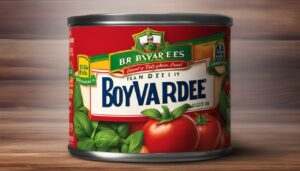Originally posted on February 10, 2024 @ 5:08 am
Have you ever wondered how unbleached flour can affect the taste of your favorite recipes? In this article, we will explore the differences between bleached and unbleached flour and how they can influence the flavor, texture, and appearance of your baked goods. Whether you’re a novice baker or an experienced chef, understanding the role of flour in your recipes is essential for achieving the desired results.
Contents
- 1 What is Bleached Flour?
- 2 What is Unbleached Flour?
- 3 Texture and Appearance Differences
- 4 Taste Differences
- 5 Baking Outcomes
- 6 Nutritional Profile
- 7 Safety Considerations
- 8 Recipe Recommendations
- 9 Conclusion
- 10 FAQ
- 10.1 Does unbleached flour change the taste of a recipe?
- 10.2 What is bleached flour?
- 10.3 What is unbleached flour?
- 10.4 What are the texture and appearance differences between bleached and unbleached flour?
- 10.5 Are there taste differences between bleached and unbleached flour?
- 10.6 How do baking outcomes differ when using bleached or unbleached flour?
- 10.7 What is the nutritional profile of bleached and unbleached flour?
- 10.8 Are there any safety considerations when using bleached flour?
- 10.9 Which flour should I use for specific recipes?
- 11 Source Links
Key Takeaways:
- Unbleached flour undergoes natural aging, while bleached flour is chemically processed.
- Bleached flour has a finer texture and a whiter appearance compared to unbleached flour.
- Taste differences between the two types of flour are subtle, but some individuals may notice a slight bitter taste in bleached flour.
- Baking outcomes can vary, with bleached flour resulting in tender and rich baked goods, while unbleached flour may produce slightly denser treats.
- The choice between bleached and unbleached flour depends on personal preference and the specific recipe being prepared.
What is Bleached Flour?

Bleached flour refers to the flour that has undergone a chemical aging process to whiten it and make it more absorbent. This process involves the use of bleaching agents, such as benzoyl peroxide or chlorine dioxide. These agents break down the starches and proteins in the flour, resulting in a softer texture and a whiter appearance. The bleaching process is faster and more consistent compared to natural aging, which makes it a preferred choice for commercial flour production.
When flour is bleached, it goes through a series of chemical reactions that alter its structure and properties. The bleaching agents, like benzoyl peroxide, react with the flour proteins and starches, breaking them down into smaller components. This breakdown process leads to changes in the flour’s texture and color, resulting in a softer and whiter product.
The use of bleaching agents in flour production has benefits for baking purposes. Bleached flour has improved water absorption, which means it can hold more moisture during the baking process. This can result in lighter, more tender baked goods. The bleaching process also helps to weaken the gluten-forming proteins in the flour, making it suitable for delicate baked goods that require a softer texture.
Although bleached flour is commonly used in commercial baking, it is worth noting that some individuals may prefer unbleached flour due to the potential presence of chemical residues in bleached flour. Nonetheless, the FDA regulates the use of bleaching agents in flour, ensuring they are within safe limits for consumption.
What is Unbleached Flour?

Unbleached flour is flour that has been naturally aged over time without the use of chemical agents. Unlike bleached flour, which undergoes a fast and consistent chemical bleaching process, unbleached flour takes a more gradual route to achieve its desired characteristics. The natural aging process involves exposing the flour to oxygen from the air, allowing it to change its chemical structure over time.
During this aging process, unbleached flour develops a stronger gluten network, which contributes to its ability to hold shape and provide structure to baked goods. The gluten-forming proteins in the flour become more stable and elastic, helping to create a desirable texture in various recipes.
Additionally, the natural aging process lightens the color of unbleached flour. Initially, unbleached flour may have a slightly off-white or yellow tint, but this gradually fades as it ages, resulting in a lighter white color.
Unbleached flour is known for its reliability and consistency. Bakers often prefer unbleached flour for its ability to produce consistent results in a wide range of baking applications. Whether you’re making bread, cookies, or pastries, unbleached flour can be a go-to choice for many recipes.
“Unbleached flour undergoes a natural aging process, resulting in a stronger gluten network and lighter color. Its gradual development makes it a dependable choice for various baking recipes.”
Texture and Appearance Differences

When it comes to the texture and appearance of flour, there are distinct differences between bleached and unbleached varieties.
Bleached flour typically has a finer grain and softer texture compared to unbleached flour, which has a denser grain and tougher texture. The bleaching process breaks down the starches and proteins in the flour, resulting in a lighter, more delicate texture.
On the other hand, unbleached flour retains more of its natural structure, giving it a slightly denser consistency. This can be attributed to the lack of chemical agents used in the bleaching process.
In terms of appearance, bleached flour is known for its stark white color, which is achieved through the use of bleaching agents. Unbleached flour, on the other hand, has an off-white or yellow tint that fades with natural aging.
Understanding these texture and appearance differences between bleached and unbleached flour can help you make informed choices when selecting the right type of flour for your recipes.
Taste Differences

When it comes to the taste of flour, there is a minimal difference between bleached and unbleached varieties. However, individuals with a very sensitive palate may detect a slight bitter taste in bleached flour due to the chemicals used in the bleaching process. On the other hand, unbleached flour undergoes a natural aging process and does not undergo any chemical treatment, resulting in a more neutral and natural flavor.
While the taste difference between bleached and unbleached flour is generally subtle, it’s important to consider the impact it may have on your recipes. If you’re baking something delicate or where the taste of the flour plays a prominent role, opting for unbleached flour may be a better choice. However, for recipes where the taste of the flour is less important or masked by other flavors, either type of flour can be used interchangeably without significantly affecting the final outcome.
Ultimately, the taste difference between bleached and unbleached flour may vary from person to person. Some may notice a distinct flavor difference, while others may not perceive any noticeable change. It’s always a good idea to experiment with both types of flour in your recipes and see which one you prefer based on your personal taste preferences.
Baking Outcomes

When it comes to baking, the type of flour used can have a significant impact on the outcome of your recipes. Bleached flour and unbleached flour, in particular, can result in different textures and flavors in your baked goods.
Effect of Bleached Flour on Baked Goods: Bleached flour, known for its softer and more absorbent nature, is commonly used in cake making. Its ability to take on more fat and sugar during baking results in a tender and rich final product with a softer texture. In fact, the invention of bleached flour played a significant role in the development of boxed cake mixes, as it helps create the desired texture and flavor.
Baking Outcomes with Unbleached Flour: On the other hand, unbleached flour may produce slightly denser baked goods compared to bleached flour. However, this does not mean that unbleached flour is an inferior choice. In fact, unbleached flour can be used interchangeably with bleached flour in most recipes without significant alterations to the final outcome. The slight difference in texture may even be preferred for certain recipes, such as puff pastries, eclairs, yeast breads, and popovers.
When choosing between bleached and unbleached flour for your baking needs, consider the desired texture and outcome of your recipe. Experimenting with both types of flour can help you discover the nuances in flavor and texture that each one offers. Ultimately, it’s all about personal preference and the specific recipe you are preparing.
Nutritional Profile

The nutritional values of bleached and unbleached flour are nearly identical. Both types contain similar amounts of calories, protein, fat, carbs, and fiber per cup. However, unbleached, unrefined whole-wheat flour may have a higher content of certain nutrients like fiber, vitamin E, manganese, copper, and antioxidants compared to bleached flour. Both types of flour are often enriched with B vitamins like folate, niacin, vitamin B6, and thiamine to enhance their nutritional content.
Below is a detailed comparison of the nutritional content of bleached and unbleached flour:
| Nutrient | Bleached Flour | Unbleached Flour |
|---|---|---|
| Calories | 364 | 364 |
| Protein (g) | 9.6 | 9.6 |
| Fat (g) | 1.2 | 1.2 |
| Carbohydrates (g) | 76.9 | 76.9 |
| Fiber (g) | 3.4 | 4.5 |
| Vitamin E (mg) | 0.1 | 0.4 |
| Manganese (mg) | 0.5 | 2.1 |
| Copper (mg) | 0.1 | 0.4 |
| Antioxidants | Low | Higher |
Both bleached and unbleached flour have their own nutritional benefits, depending on the specific nutrients you’re looking for. Unbleached, unrefined whole-wheat flour is a good choice if you’re seeking higher fiber content and a range of vitamins and minerals. However, both types of flour can be enriched with B vitamins, ensuring an adequate nutritional profile for most individuals.
Safety Considerations
The safety of bleached flour is a topic of concern due to the use of chemical agents in the bleaching process. Two commonly used chemicals in bleached flour are potassium bromate and benzoyl peroxide.
Potassium Bromate: In bread-making, potassium bromate is a common additive to improve dough strength and volume. However, studies have shown that potassium bromate can be harmful to human health. Animal studies have linked its consumption to kidney damage and cancer. As a result, it is banned in several countries, including the European Union. In the United States, the use of potassium bromate is still permitted, but it requires strict adherence to labeling regulations.
“Potassium bromate, a common additive in bread-making, has been linked to kidney damage and cancer in animal studies.”
Benzoyl Peroxide: Benzoyl peroxide is another chemical used in the bleaching process of flour. It is generally recognized as safe by the FDA when used in low concentrations. However, studies have found that benzoyl peroxide may have negative effects on antioxidant status and the breakdown of certain nutrients in the body.
It is important to note that the potential health risks associated with bleached flour are still being researched. More studies are needed to evaluate the long-term effects of consuming bleached flour in normal amounts.
The Safety of Bleached Flour Table
| Chemical Agent | Potential Health Risks | Regulations |
|---|---|---|
| Potassium Bromate | Kidney damage, cancer | Illegal in several countries, including the EU |
| Benzoyl Peroxide | Negative effects on antioxidants, nutrient breakdown | Generally recognized as safe by the FDA |
It is advisable to choose unbleached flour or alternatives if you are concerned about the safety of bleached flour. Always review product labels and consult with healthcare professionals for personalized advice.
Recipe Recommendations
The choice between using bleached or unbleached flour in recipes often comes down to personal preference and the desired outcome of the baked goods. Here are some recommendations on which flour to use for specific recipes:
Bleached Flour:
Bleached flour, with its finer texture and higher absorbency, is well-suited for the following recipes:
- Cookies
- Pancakes
- Waffles
- Quick Breads
- Pie Crusts
Unbleached Flour:
Unbleached flour, with its denser texture, helps baked goods hold their shape. It is commonly used in the following recipes:
- Puff Pastries
- Eclairs
- Yeast Breads
- Popovers
However, both types of flour can generally be used interchangeably in most recipes without significant alterations to the final product.
Recipe Recommendation Table:
| Recipe Type | Bleached Flour | Unbleached Flour |
|---|---|---|
| Cookies | ✔️ | ❌ |
| Pancakes | ✔️ | ❌ |
| Waffles | ✔️ | ❌ |
| Quick Breads | ✔️ | ❌ |
| Pie Crusts | ✔️ | ❌ |
| Puff Pastries | ❌ | ✔️ |
| Eclairs | ❌ | ✔️ |
| Yeast Breads | ❌ | ✔️ |
| Popovers | ❌ | ✔️ |
Conclusion
In conclusion, the choice between bleached and unbleached flour can significantly impact the taste, texture, and appearance of your recipes. Bleached flour, with its whiter color and softer texture, is ideal for creating tender and delicate baked goods. On the other hand, unbleached flour offers a slightly denser grain, giving baked treats a heartier consistency.
While there are minimal taste differences between the two types of flour, bleached flour may have a subtle bitter taste due to the chemicals used in the bleaching process. Unbleached flour, being aged naturally, retains a more neutral flavor.
When it comes to baking outcomes, bleached flour yields tender and rich results, while unbleached flour may produce slightly denser treats. However, both can be used interchangeably in most recipes without significant alterations to the final product.
The safety aspect is important to consider, as the use of chemicals in bleached flour raises some concerns. While more research is needed, it is advisable to be cautious about the potential health risks associated with consuming bleached flour in normal amounts.
In the end, the choice between bleached and unbleached flour depends on personal preference and the specific recipe at hand. Whether you prioritize a lighter texture, a more vibrant appearance, or a more natural baking process, both types of flour have their own unique characteristics to offer.
FAQ
Does unbleached flour change the taste of a recipe?
Unbleached flour has minimal taste differences compared to bleached flour. However, individuals with a sensitive palate may notice a slightly bitter taste in bleached flour due to the chemicals used in the bleaching process. Unbleached flour, being aged naturally, does not undergo a chemical treatment and therefore retains a more neutral flavor.
What is bleached flour?
Bleached flour refers to flour that has undergone a chemical aging process to whiten it and make it more absorbent. This involves the use of bleaching agents like benzoyl peroxide or chlorine dioxide. The bleaching process affects the color, texture, taste, and baking outcomes of recipes, particularly in cakes and boxed cake mixes.
What is unbleached flour?
Unbleached flour is flour that has been naturally aged over time without the use of chemical agents. During natural aging, oxygen from the air changes the chemical structure of the flour, strengthening the gluten-forming proteins and lightening the color. Unbleached flour has a denser grain and tougher texture compared to bleached flour.
What are the texture and appearance differences between bleached and unbleached flour?
Bleached flour typically has a finer grain and softer texture, while unbleached flour has a denser grain and tougher texture. The bleaching process breaks down the starches and proteins in the flour, resulting in a lighter, more delicate texture. Additionally, bleached flour is whiter in color, while unbleached flour has an off-white or yellow tint that fades with natural aging.
Are there taste differences between bleached and unbleached flour?
While there is minimal difference in taste between bleached and unbleached flour, individuals with a very sensitive palate may notice a slightly bitter taste in bleached flour due to the chemicals used in the bleaching process. Unbleached flour, being aged naturally, does not undergo a chemical treatment and therefore retains a more neutral flavor.
How do baking outcomes differ when using bleached or unbleached flour?
The use of bleached flour in baking can have a noticeable impact on the outcome of recipes, especially in cake making. Bleached flour is softer and more absorbent, allowing baked goods to take on more fat and sugar. This results in a tender and rich final product with a softer texture. Unbleached flour, although it may produce slightly denser baked goods, can still be used interchangeably with bleached flour in most recipes without significant alterations to the final outcome.
What is the nutritional profile of bleached and unbleached flour?
The nutritional values of bleached and unbleached flour are nearly identical. Both types contain similar amounts of calories, protein, fat, carbs, and fiber per cup. However, unbleached, unrefined whole-wheat flour may have a higher content of certain nutrients like fiber, vitamin E, manganese, copper, and antioxidants compared to bleached flour. Both types of flour are often enriched with B vitamins like folate, niacin, vitamin B6, and thiamine to enhance their nutritional content.
Are there any safety considerations when using bleached flour?
The use of chemical agents in the bleaching process has raised some safety concerns. For example, potassium bromate, a common additive in bread-making, has been linked to kidney damage and cancer in animal studies. While it is illegal in several countries, including the European Union, its use is still permitted in the United States. Benzoyl peroxide is another chemical used in bleached flour but is generally recognized as safe by the FDA. However, studies have shown that it may have negative effects on antioxidant status and the breakdown of certain nutrients. More research is needed to evaluate the safety of bleached flour when consumed in normal amounts.
Which flour should I use for specific recipes?
The choice between using bleached or unbleached flour in recipes often depends on personal preference and the desired outcome of the baked goods. Bleached flour, with its finer texture and higher absorbency, is well-suited for recipes like cookies, pancakes, waffles, quick breads, and pie crusts. Unbleached flour, with its denser texture, helps baked goods hold their shape and is commonly used in puff pastries, eclairs, yeast breads, and popovers. However, both types of flour can generally be used interchangeably in most recipes without significant alterations to the final product.








